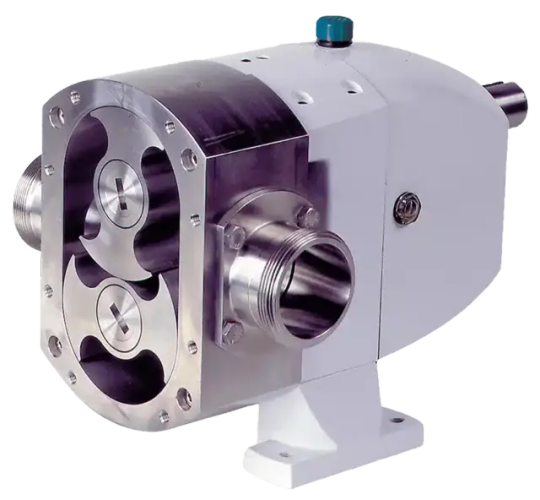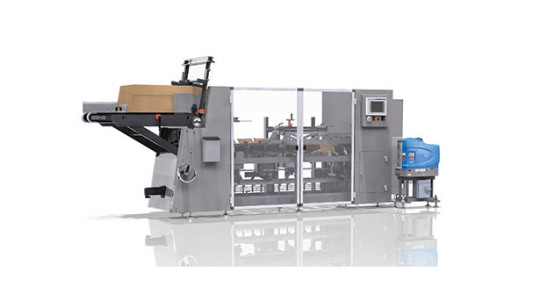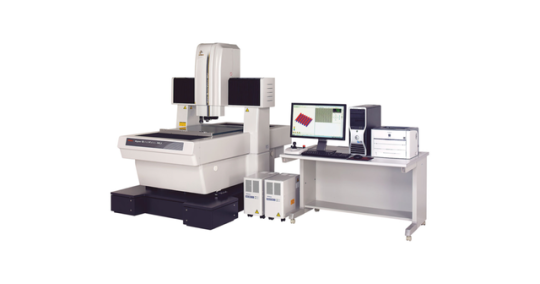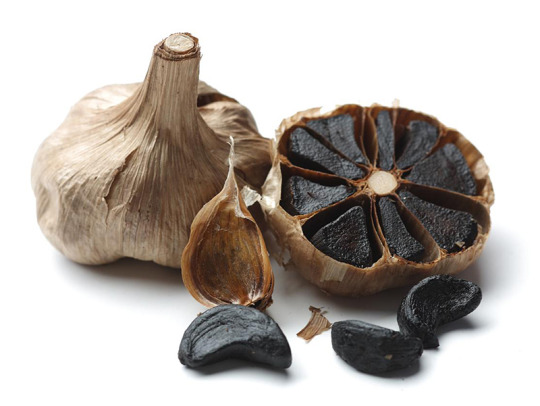Don't wanna be here? Send us removal request.
Text
Rotary Pumps Market Future Trends Shaped by Efficiency, Sustainability, and Digital Transformation
The rotary pumps market is evolving rapidly, driven by the need for efficiency, reliability, and sustainability across diverse industrial applications. As fluid handling requirements grow more complex, the future of rotary pump technologies lies in innovation and adaptability. Industries such as oil & gas, water treatment, food processing, pharmaceuticals, and chemicals are reshaping demand profiles, pushing manufacturers to design smarter, greener, and more flexible pumping systems.
This article explores key future trends that are expected to shape the rotary pumps market in the coming years.

Growing Adoption of Smart and Connected Pump Systems
One of the most significant trends influencing the future of rotary pumps is the integration of smart technologies. The push toward digitalization is leading to the development of intelligent pump systems equipped with sensors, real-time monitoring capabilities, and predictive maintenance algorithms.
These smart rotary pumps can self-diagnose performance issues, reduce downtime, and optimize energy consumption through automated adjustments. With the adoption of Industry 4.0 and Internet of Things (IoT) in manufacturing and utility sectors, connected pumps are gaining traction as essential components of modern infrastructure.
Remote access and control features are also becoming standard, allowing operators to manage pump performance across multiple sites from centralized platforms. This trend is set to redefine how rotary pumps are monitored, maintained, and integrated into broader fluid management systems.
Sustainability and Energy Efficiency Driving Design Innovation
Sustainability is no longer a secondary consideration—it is now a critical driver of product development across the rotary pumps market. Industries are under pressure to lower carbon emissions, reduce water and energy usage, and comply with stringent environmental regulations.
As a result, manufacturers are investing in energy-efficient designs that minimize friction losses, improve volumetric efficiency, and support variable-speed operations. Pumps that consume less energy while delivering consistent performance are gaining preference in sectors like wastewater treatment, where operational costs and environmental impacts are closely monitored.
Materials are also evolving, with corrosion-resistant, lightweight, and recyclable components being prioritized to extend pump lifespan and reduce environmental footprint. The future will likely see more pumps engineered for high efficiency and minimal ecological impact.
Rise in Demand from Water and Wastewater Management
Global water scarcity and rising wastewater volumes are intensifying the need for advanced fluid transfer systems. Rotary pumps, known for their steady flow and reliability, are being increasingly deployed in municipal water utilities, industrial wastewater systems, and desalination plants.
The market is witnessing growing demand for rotary pumps that can handle abrasive and viscous fluids while maintaining low maintenance needs. In regions experiencing water stress or infrastructure modernization, such as Asia-Pacific, Africa, and the Middle East, rotary pumps are becoming vital assets in sustainable water management.
This demand is projected to rise as governments and industries continue to invest in water conservation technologies and resilient infrastructure systems to combat climate change and population growth.
Customization and Application-Specific Solutions on the Rise
The future of the rotary pumps market lies in tailored, application-specific solutions rather than standard, one-size-fits-all designs. End-users are seeking pumps that align precisely with their process requirements, fluid characteristics, and space constraints.
This has led to the growing popularity of modular pumps that allow customization in terms of materials, seals, motors, and flow configurations. In chemical processing or food & beverage industries, for example, hygiene, temperature tolerance, and fluid compatibility are critical—driving demand for rotary pumps engineered to exacting standards.
By offering a high degree of customization, manufacturers are positioning themselves as long-term partners in operational success, enhancing their competitiveness in a crowded marketplace.
Emphasis on Low-Noise, Low-Vibration, and Compact Pumps
As industries prioritize worker safety, comfort, and equipment longevity, there is a noticeable shift toward rotary pumps that operate quietly and smoothly. Low-noise and low-vibration designs are increasingly favored in indoor installations, mobile equipment, and residential or medical environments.
Additionally, compact pump systems with high power-to-size ratios are gaining market traction, particularly in space-limited settings like offshore rigs, mobile water treatment units, and skid-mounted systems. This trend is pushing innovation in design, motor integration, and mounting configurations to ensure performance without sacrificing space efficiency.
Emerging Markets and Infrastructure Development Fueling Growth
Emerging economies are playing a crucial role in shaping the future of the rotary pumps market. Regions such as Southeast Asia, Latin America, and Sub-Saharan Africa are witnessing a surge in infrastructure development, including new power plants, water utilities, food manufacturing units, and chemical processing facilities.
This infrastructure boom is creating new opportunities for rotary pump manufacturers, especially those offering durable, easy-to-maintain systems suitable for diverse operational environments. Local partnerships, after-sales service networks, and regional customization will be key to succeeding in these high-growth markets.
Conclusion
The rotary pumps market is on the cusp of transformation, with future trends driven by sustainability, smart technology, and application-centric design. As industries evolve, so do their expectations from pumping solutions—focusing more on efficiency, reliability, and long-term value.
By embracing digitalization, enhancing energy performance, supporting customization, and addressing regional market dynamics, manufacturers can stay ahead of the curve. The next generation of rotary pumps will not only move fluids—but also move industries toward smarter, cleaner, and more responsive operations.
0 notes
Text
Wrap Around Cartoners Market Drivers Shaping Automation, Efficiency, and Packaging Innovations Globally
The wrap around cartoners market has emerged as a pivotal segment in the broader packaging machinery industry. As industries across food & beverage, personal care, pharmaceuticals, and household goods seek faster, more flexible, and efficient packaging systems, wrap around cartoners continue to gain traction. These machines offer the capability to form, fill, and seal cartons around products in a single automated line, optimizing packaging time and reducing labor dependency. A combination of technological, economic, environmental, and operational drivers are influencing the rapid growth and innovation in this market.

1. Rising Demand for Automation in Packaging Lines
One of the primary drivers of the wrap around cartoners market is the global push toward automation. Industries are increasingly replacing manual processes with automated systems to enhance speed, consistency, and output. Wrap around cartoners, known for their continuous motion and high-speed capability, fulfill this requirement effectively. With the growing trend of Industry 4.0 and smart manufacturing, companies are integrating these machines with sensors, machine learning tools, and real-time monitoring features, further boosting their appeal.
In particular, the food and beverage sector is aggressively adopting wrap around cartoners for packaging bottled drinks, canned food, and dairy products. This adoption is fueled by the need to meet high-volume production schedules while maintaining packaging precision and reducing waste.
2. Cost and Space Efficiency as a Competitive Advantage
Compared to traditional side-load cartoners, wrap around models offer significant cost and space advantages. Their compact design and streamlined process reduce floor space usage and operational costs. Manufacturers aiming for lean production systems see these machines as valuable investments.
Moreover, these cartoners consume less energy per operation and offer quick changeovers between different carton sizes, which enhances operational flexibility. In high-mix, low-volume production environments, this adaptability becomes a critical asset for businesses targeting multiple product formats and seasonal demand variations.
3. Growth of E-Commerce and Shelf-Ready Packaging
The boom in e-commerce has led to a shift in packaging needs, with more emphasis on secure, efficient, and presentable packaging formats. Wrap around cartoners offer a tamper-proof and tightly packed solution that ensures the product remains safe during transit and handling.
Additionally, retail chains are demanding shelf-ready packaging (SRP) for easy stocking and display. Wrap around cartoners enable the creation of SRP by producing packages that can be directly placed on retail shelves without additional unpacking. This trend is particularly strong in Europe and North America, further pushing the demand for such packaging equipment.
4. Sustainability and Material Optimization
Environmental concerns and regulatory pressures are driving packaging companies to adopt eco-friendly practices. Wrap around cartoners support the use of recyclable and biodegradable packaging materials and can optimize material use through precise wrapping and reduced wastage. They eliminate the need for excess filler or shrink wrap, aligning well with sustainability goals.
Brands are also shifting from plastic-based packaging to corrugated or paperboard alternatives. Wrap around cartoners are highly compatible with these materials, enabling businesses to meet sustainability targets without compromising packaging efficiency.
5. Pharmaceutical and Personal Care Sector Expansion
The growth of the pharmaceutical and personal care industries—especially post-pandemic—has opened new opportunities for wrap around cartoners. These sectors require hygienic, tamper-proof, and consistent packaging solutions, which these machines provide. Moreover, with increasing regulatory scrutiny on labeling, traceability, and safety in pharmaceuticals, automated cartoning systems offer precise control and quality assurance.
Additionally, in personal care, where product variety is vast, the versatility of wrap around cartoners enables fast adaptation to changing SKUs and branding needs.
6. Emerging Markets and Industrial Modernization
Emerging economies in Asia-Pacific, Latin America, and parts of Africa are experiencing rapid industrial growth and modernization. With increasing investments in food processing, healthcare, and manufacturing, the demand for advanced packaging solutions like wrap around cartoners is on the rise. Governments and private players are investing in infrastructure and automated production to meet rising domestic and export demands.
In these regions, lower labor costs previously made manual packaging more viable, but the shift toward higher productivity and global quality standards is changing the scenario in favor of automation.
Conclusion
The wrap around cartoners market is being propelled by a dynamic mix of drivers ranging from automation and cost efficiency to sustainability and changing consumer demands. As industries continue to evolve and adopt smarter packaging systems, the relevance and demand for wrap around cartoners are expected to accelerate. Manufacturers that innovate around flexibility, energy efficiency, and integration capabilities are likely to capture significant opportunities in this growing market segment.
#WrapAroundCartonersMarket#PackagingMachinery#AutomationInPackaging#SmartManufacturing#SustainablePackaging
0 notes
Text
Visual Effects (VFX) Software Market Future Trends Driven by AI, Real-Time Rendering, and Cloud
The Visual Effects (VFX) software market is entering a transformative era, shaped by technological evolution, growing content consumption, and demand for immersive visual experiences. As digital media continues to expand its influence across entertainment, advertising, virtual production, and gaming, future trends in the VFX software market point to a dynamic, fast-paced environment driven by innovation and collaboration.

A major trend defining the future of VFX software is the integration of artificial intelligence (AI) and machine learning (ML) into creative workflows. AI-powered tools are being developed to automate time-consuming processes such as rotoscoping, motion tracking, color correction, and environment modeling. This automation not only boosts productivity but also allows artists to focus more on storytelling and creative elements. ML algorithms can learn from visual data and predict patterns, helping software generate realistic textures, lighting, and physics simulations with reduced manual input.
Real-time rendering is another key trend revolutionizing the VFX industry. Fueled by advancements in game engines like Unreal Engine and Unity, real-time VFX enables artists to view and adjust visual effects immediately without the need for time-intensive render queues. This trend is particularly impactful in virtual production environments, where real-time compositing and green screen replacement enable filmmakers to see final results on-set. The shift towards real-time technologies is shortening production timelines and improving overall project efficiency.
Cloud-based VFX workflows are also gaining traction as studios and content creators seek flexibility, scalability, and remote collaboration capabilities. With cloud rendering, artists can access high-performance computing resources without investing in expensive local hardware. This approach allows global teams to collaborate seamlessly on the same project, reducing infrastructure costs and enabling faster iteration. Cloud platforms are also integrating with VFX software to offer subscription models and centralized asset management, making complex productions more manageable for both large studios and independent creators.
Another future trend is the increased adoption of VFX in non-traditional industries, such as education, healthcare, architecture, and e-commerce. For instance, AR/VR-enhanced educational content, 3D product visualization, and medical simulations are incorporating advanced visual effects to deliver more engaging and interactive experiences. This diversification is expanding the VFX software market beyond the boundaries of film and TV.
The demand for hyper-realistic digital humans and virtual influencers is pushing software capabilities to new heights. VFX software developers are now focusing on facial animation, skin rendering, and emotional expression tools that can bring digital characters to life with uncanny realism. As these tools become more accessible, their applications in social media marketing, gaming, and metaverse environments are expected to grow significantly.
Cross-platform compatibility and interoperability are also influencing future software development. VFX artists often use multiple tools in a single workflow—such as Autodesk Maya for modeling, Houdini for simulations, and Nuke for compositing. To streamline this process, there is a growing emphasis on developing open-source frameworks and common standards like USD (Universal Scene Description), allowing seamless data exchange between software packages.
The VFX software market is also expected to benefit from increased content demand from OTT platforms, including Netflix, Amazon Prime Video, and Disney+. These platforms are investing heavily in original content with high production values, driving up the need for advanced VFX capabilities. Episodic series, in particular, are now receiving cinematic-level effects, further fueling demand for efficient and scalable VFX software solutions.
On the gaming front, the rise of cinematic storytelling in games is increasing the demand for high-fidelity visual effects. Game developers are turning to VFX tools to craft complex lighting, explosions, weather systems, and character effects that enhance gameplay immersion. As gaming hardware continues to improve, VFX software will evolve to match the demand for visually stunning, real-time interactive environments.
In addition, sustainability and energy efficiency are emerging concerns in VFX production. Cloud platforms are starting to offer green computing options, and developers are working on algorithms that optimize rendering performance to reduce carbon footprints. Studios are increasingly aware of their environmental responsibilities, and future VFX solutions are expected to align with these values.
In conclusion, the future of the Visual Effects (VFX) software market is being shaped by AI-driven automation, real-time rendering, cloud computing, and cross-industry applications. These trends are unlocking new creative possibilities while streamlining workflows, expanding market reach, and increasing accessibility. As digital experiences continue to evolve and audiences seek more immersive content, VFX software will remain at the forefront of visual storytelling, innovation, and technological advancement. The coming years promise exciting developments, and those who embrace these trends early will be best positioned to lead in the next era of visual effects.
0 notes
Text
Video Measuring System Market Drivers Include Precision Demand, Automation Growth, and Inspection Advancements
The global video measuring system market is expanding rapidly, driven by a combination of factors that are transforming the way industries approach dimensional inspection, quality control, and process optimization. As manufacturers move toward more complex designs and tighter tolerances, traditional measurement methods often fall short, opening the door for advanced video-based systems. These systems provide high-speed, non-contact, and high-accuracy measurements, which are increasingly critical in modern production environments.

One of the primary drivers of the video measuring system market is the growing demand for precision in manufacturing. Industries such as aerospace, automotive, electronics, and medical devices are evolving toward highly intricate components with exacting specifications. In these sectors, even microscopic deviations can lead to product failures or regulatory non-compliance. Video measuring systems offer exceptional accuracy and repeatability, enabling manufacturers to maintain quality standards and reduce defect rates. Their ability to detect minute variations without damaging the parts being inspected makes them invaluable for manufacturers aiming for zero-defect production.
Another key growth catalyst is the rise in automation and Industry 4.0 practices. As smart factories become the norm, companies are seeking systems that can integrate seamlessly into automated workflows. Video measuring systems are well-suited for this environment, as they can be embedded into robotic arms or inline inspection stations to perform real-time measurements during production. This reduces downtime, minimizes human intervention, and ensures continuous quality assurance. Moreover, these systems often come equipped with software capable of analyzing data on the fly, identifying trends, and even predicting failures before they occur — an essential capability in predictive maintenance strategies.
The electronics and semiconductor sectors are also major contributors to market expansion. With the ongoing miniaturization of devices, component measurements need to be more precise than ever. Video measuring systems can measure intricate microfeatures on circuit boards and chips without physical contact, thus preventing damage and maintaining measurement fidelity. This non-invasive approach is crucial in ensuring the structural and functional integrity of delicate components.
In addition, the increasing focus on regulatory compliance and quality certifications is pushing manufacturers to invest in advanced metrology solutions. As global trade becomes more competitive and regulations more stringent, demonstrating compliance through reliable and verifiable inspection data is essential. Video measuring systems generate digital reports and data logs that can be used to trace product quality throughout the supply chain. This transparency helps businesses meet certification requirements while building trust with stakeholders.
Furthermore, technological advancements are playing a major role in expanding the market. Innovations such as multi-sensor systems, 3D video measurement, and AI-based image recognition have significantly enhanced the capabilities of these devices. These technologies enable faster measurements, better feature recognition, and more accurate decision-making. For example, systems equipped with artificial intelligence can identify complex geometric features, adjust lighting automatically, and detect defects that might be overlooked by the human eye.
Cost efficiency is another factor driving adoption, especially among small and medium-sized enterprises (SMEs). Earlier, video measuring systems were considered a high-end investment limited to large manufacturers. However, falling sensor prices, user-friendly software, and compact system designs have made them accessible to a broader audience. SMEs can now leverage these tools to improve product quality, increase throughput, and remain competitive without heavy capital expenditure.
Environmental sustainability is also influencing market dynamics. Video measuring systems help reduce material waste by detecting defects early in the production process. Additionally, since they operate without physical contact, there's no wear and tear on the measurement tool or the product being inspected, extending equipment lifespan and reducing resource consumption. Manufacturers aiming for sustainable operations are increasingly viewing these systems as a part of their green manufacturing strategy.
Finally, the global expansion of manufacturing hubs, particularly in emerging economies, is fueling market demand. As countries like India, Vietnam, and Mexico strengthen their industrial sectors, the need for advanced quality assurance tools grows. Government initiatives promoting local manufacturing and exports are also encouraging adoption of technologies that can ensure international quality standards.
In summary, the video measuring system market is propelled by a strong combination of drivers: the need for precision, integration with automation, regulatory compliance, technological innovation, affordability, and sustainability. These systems are not just improving measurement accuracy; they are redefining how industries think about inspection and quality assurance in the era of smart manufacturing. As these trends continue, the market is poised for robust growth across a wide range of sectors globally.
#VideoMeasuringSystemmarket#IndustrialAutomation#SmartManufacturing#PrecisionEngineering#QualityControl
0 notes
Text
Velvet Lamination Films Market Insights on Evolving Trends, Applications, and Global Demand Shift
The velvet lamination films market has witnessed steady growth over the past decade, driven by rising consumer demand for premium packaging and enhanced aesthetic appeal in print media. As industries continue to focus on brand differentiation and tactile experience, velvet lamination films are gaining momentum across sectors such as cosmetics, fashion, luxury goods, and high-end publications. These soft-touch films not only elevate product presentation but also offer added durability and a sophisticated matte finish that aligns with modern design preferences.

One of the key insights into the velvet lamination films market is the growing influence of consumer experience in packaging choices. Brands are increasingly opting for tactile finishes that evoke a sense of luxury and exclusivity. Velvet lamination achieves this with its unique texture—soft, suede-like, and visually rich. As a result, companies in cosmetics, perfumes, gourmet foods, and premium electronics are integrating velvet films into their outer packaging to strengthen brand perception and improve customer engagement.
From a material standpoint, manufacturers are innovating to develop eco-friendly and recyclable velvet lamination options, addressing growing concerns over sustainability. Traditionally made using BOPP (biaxially oriented polypropylene) or PET (polyethylene terephthalate), new product developments now incorporate bio-based films or films with lower carbon footprints. This transition reflects a broader movement across industries where environmental compliance and green packaging are becoming competitive differentiators.
Regionally, North America and Europe continue to be dominant markets due to their high consumption of premium goods and strong print finishing industries. However, rapid urbanization, a booming e-commerce sector, and rising middle-class income in Asia-Pacific are propelling significant demand in countries such as India, China, and South Korea. These regions are witnessing increased use of velvet films in online retail packaging, especially for fashion and lifestyle products that aim to deliver an elevated unboxing experience.
Another compelling insight is the rising use of velvet lamination films in commercial printing. Whether for business cards, catalogs, book covers, or brochures, velvet films provide a protective coating that resists fingerprints, scratches, and smudges—critical features for maintaining visual quality over time. Moreover, their compatibility with foil stamping and spot UV processes allows creative professionals to experiment with bold, elegant effects without sacrificing durability.
The market is also experiencing a surge in demand from the luxury beverage industry. Wine, spirits, and premium non-alcoholic beverages are increasingly adopting velvet-laminated labels and packaging to convey refinement and craftsmanship. These visual and tactile enhancements not only draw consumer attention but also signal quality and exclusivity on crowded retail shelves.
Technological advancements in lamination machinery and film application processes are helping reduce production costs and improve efficiency. New coating techniques now enable better adhesion and faster drying times, which is critical for large-scale printing and packaging operations. These improvements are encouraging small and mid-sized printers to adopt velvet lamination as part of their value-added services.
Despite the growing opportunities, the velvet lamination films market faces certain challenges. The relatively higher cost compared to standard matte or gloss films remains a concern for price-sensitive sectors. Additionally, proper waste management and recycling of laminated products continue to be hurdles, especially in regions with underdeveloped recycling infrastructure. Industry players are addressing these issues by offering custom solutions and investing in R&D for compostable and reusable films.
The competitive landscape is composed of both global players and regional manufacturers, with ongoing partnerships between film producers, printing companies, and packaging brands. These collaborations aim to develop innovative finishes, improve application efficiency, and meet specific customer demands. Strategic investments in product development, marketing, and supply chain optimization are central to sustaining long-term growth.
In conclusion, the velvet lamination films market is being reshaped by evolving consumer preferences, technological innovation, and increased demand for premium, sustainable packaging solutions. As more industries explore ways to enhance product presentation and align with environmental goals, velvet lamination films are expected to play a key role in delivering both tactile sophistication and functional value. The future of this market hinges on the ability of manufacturers to balance design innovation with cost-effectiveness and eco-conscious practices.
#VelvetLaminationFilmsMarket#LaminationMarketInsights#PackagingInnovation#PremiumPackaging#SoftTouchFilms
0 notes
Text
Vaccine Packaging Market Drivers Strengthening Global Immunization Supply Chain and Regulatory Compliance
The vaccine packaging market is experiencing a strong upward trajectory, driven by multiple interconnected factors that are reshaping the global healthcare ecosystem. As immunization efforts expand across both developed and emerging regions, the need for reliable, safe, and efficient packaging solutions becomes increasingly crucial. From material innovations to evolving regulatory frameworks and cold chain demands, several drivers are powering the sustained growth of this vital market segment.

Global Immunization Programs Fueling Demand
One of the foremost drivers of the vaccine packaging market is the aggressive rollout of global vaccination campaigns. Organizations like WHO, GAVI, and UNICEF continue to push widespread immunization against preventable diseases such as measles, polio, and more recently, COVID-19. The scale of these efforts demands robust and scalable packaging systems that ensure vaccines remain stable, sterile, and potent during transit and storage.
Emerging economies, in particular, are ramping up public health infrastructure, leading to higher vaccine volumes. As a result, pharmaceutical companies are investing in advanced packaging materials like glass vials, prefilled syringes, and polymer containers to meet this growing demand. This surge in vaccine volume directly translates to heightened packaging needs.
Strict Regulatory Standards Enhancing Packaging Quality
Regulatory bodies such as the FDA, EMA, and other national agencies have established stringent guidelines for vaccine packaging. These include criteria on material compatibility, sterility assurance, container closure integrity, and labeling. Compliance with these guidelines ensures product safety, reduces contamination risks, and improves traceability.
The need to meet regulatory expectations has compelled manufacturers to upgrade their packaging technologies. Innovations such as tamper-evident seals, multi-layer barrier films, and smart labeling with RFID or QR codes are gaining traction. As a result, regulatory compliance is no longer just a requirement but a market driver pushing the industry toward greater sophistication.
Growth of Cold Chain Logistics Infrastructure
Vaccines are highly temperature-sensitive, with most requiring storage between 2°C and 8°C. Some newer types, such as mRNA-based vaccines, need ultra-cold conditions. The increasing need for consistent temperature control throughout the supply chain significantly impacts packaging design and materials.
This driver has led to a rise in specialized packaging solutions like insulated shippers, phase change materials, and temperature-monitoring devices. Cold chain-compatible packaging not only extends shelf life but also reduces waste due to spoilage. Thus, as countries build cold chain capacity, the demand for temperature-sensitive vaccine packaging continues to grow.
Rising Focus on Sustainability and Eco-Friendly Packaging
With global attention shifting toward environmental sustainability, the vaccine packaging sector is under pressure to adopt eco-friendly practices. Regulatory agencies and pharmaceutical companies alike are seeking recyclable, biodegradable, or reusable packaging materials that reduce environmental impact.
While ensuring product safety remains the top priority, many manufacturers are now balancing performance with environmental responsibility. The use of recycled content, reduction in packaging weight, and incorporation of sustainable materials is becoming a standard practice. This green shift is also proving to be a market differentiator for packaging suppliers.
Technological Innovations in Packaging Solutions
Another key driver is the integration of advanced technologies into vaccine packaging systems. Smart packaging, embedded sensors, and data logging features are being introduced to enhance supply chain visibility and improve safety.
These innovations allow stakeholders to track temperature, humidity, location, and even tampering during transit. Digitalization of packaging not only prevents errors but also helps reduce losses and ensure timely delivery, especially in remote or rural areas. The growing demand for digital transformation in the pharma industry continues to elevate the role of high-tech packaging.
Expansion of Biopharmaceuticals and Personalized Vaccines
The rise of personalized medicine and biotechnology-based vaccines is also contributing to market growth. Unlike traditional vaccines, these often come with specific packaging requirements due to their sensitivity, dosage variations, and delivery methods.
This diversification demands more customized packaging solutions, driving manufacturers to invest in adaptable, small-batch packaging lines. As biopharmaceutical innovation continues to advance, it creates fresh opportunities for vaccine packaging providers to offer value-added solutions tailored to individual therapies.
Conclusion
The vaccine packaging market is being propelled by a dynamic combination of health initiatives, regulatory scrutiny, cold chain evolution, and technological advancements. Each of these drivers not only supports the efficiency and safety of immunization programs but also shapes the future of healthcare packaging. As global health challenges evolve, so too will the need for smarter, safer, and more sustainable vaccine packaging solutions.
0 notes
Text
Thermoform Packaging Market Future Outlook Shows Promising Growth Across Diverse End-Use Applications
The thermoform packaging market future outlook is positive and expanding rapidly, driven by increasing demand for lightweight, cost-effective, and eco-friendly packaging solutions across multiple industries. Thermoform packaging—created by heating and molding plastic sheets into specific shapes—is widely used in sectors such as food and beverage, pharmaceuticals, electronics, personal care, and industrial goods. As global consumer and regulatory focus shifts toward sustainability, hygiene, and product protection, thermoform packaging is emerging as a preferred choice for many manufacturers and retailers.

The market is poised for strong growth over the coming years, supported by innovation in materials, automation in production processes, and the rise of circular economy practices. With its flexibility, versatility, and recyclability, thermoform packaging is well-aligned with the future needs of businesses and environmentally conscious consumers alike.
Sustainability Trends Are Accelerating Market Momentum
One of the most significant factors shaping the future of thermoform packaging is the growing emphasis on sustainable packaging solutions. With increased awareness around plastic waste and carbon emissions, manufacturers are under pressure to adopt eco-friendly materials and reduce packaging footprints. Thermoforming offers several advantages in this area, including material efficiency, lightweight construction, and the potential to use recycled or biodegradable plastics.
Companies are investing in research and development to create packaging using post-consumer recycled (PCR) content, bio-based plastics, and mono-material structures that improve recyclability. These innovations are helping brands meet environmental regulations, enhance corporate responsibility, and appeal to eco-conscious customers.
As a result, demand for sustainable thermoform solutions is expected to grow across various segments, especially in food, medical, and retail packaging.
Food Industry Remains a Major Growth Driver
The food and beverage sector continues to be the largest end-user of thermoform packaging, and its future outlook remains strong. Pre-packaged foods, ready-to-eat meals, dairy products, meat, poultry, and bakery items all require protective, attractive, and tamper-resistant packaging. Thermoform packaging provides ideal solutions with its ability to form custom shapes, create strong seals, and extend product shelf life.
With consumers prioritizing hygiene and convenience—especially post-pandemic—thermoform trays, blister packs, and clamshells have become standard in retail packaging. Moreover, advancements in modified atmosphere packaging (MAP) and vacuum sealing using thermoformed designs are gaining traction for preserving freshness in perishable items.
The rising trend of single-serve packaging, online grocery shopping, and the growing demand for visually appealing packaging further contribute to the sector’s strong future outlook.
Pharmaceutical and Medical Applications Gaining Prominence
The pharmaceutical industry is another area where thermoform packaging is witnessing growing adoption. Blister packs are widely used for pills, tablets, and capsules, offering protection from moisture, contamination, and tampering. With rising global demand for healthcare services, aging populations, and increased access to medications, the need for safe and reliable packaging is increasing.
Thermoform packaging also plays a key role in medical device packaging, where sterilization compatibility and integrity are critical. The future of this segment will likely be shaped by innovations in medical-grade materials, anti-counterfeiting features, and enhanced traceability.
As healthcare systems continue to evolve globally, the market for medical thermoform packaging is expected to expand significantly.
Technological Advancements Driving Efficiency and Customization
Technology is playing a pivotal role in transforming the thermoform packaging industry. Innovations in automation, robotics, and digital printing are helping manufacturers improve efficiency, reduce production costs, and meet the rising demand for customized packaging solutions. Thermoforming machinery is becoming faster, more energy-efficient, and capable of handling a wider range of materials.
Additionally, digital tools are enabling brands to create personalized packaging with vibrant graphics, QR codes, and interactive features that enhance consumer engagement. The trend of smart packaging, incorporating sensors or NFC tags into thermoformed packages, is also on the horizon.
These advancements are opening up new possibilities for product differentiation, brand storytelling, and data-driven decision-making in packaging strategies.
Global Market Expansion and Emerging Economies
Geographically, emerging economies in Asia-Pacific, Latin America, and the Middle East are expected to offer the highest growth potential for thermoform packaging. Urbanization, rising disposable incomes, and increased demand for packaged food, personal care, and healthcare products are driving regional market expansion.
Countries such as China, India, Brazil, and Indonesia are witnessing strong investment in manufacturing infrastructure and consumer product distribution, creating robust demand for packaging solutions. Local governments are also introducing sustainability regulations and initiatives that encourage the adoption of recyclable and eco-friendly packaging.
As a result, global manufacturers are expanding their operations and distribution networks in these high-potential markets to capture future growth.
Conclusion
The thermoform packaging market future outlook is marked by innovation, sustainability, and strategic expansion. As industries across the globe respond to changing consumer behaviors, regulatory requirements, and environmental challenges, thermoform packaging stands out as a versatile and forward-looking solution. With applications spanning food, pharma, electronics, and beyond, the market is set for continued growth driven by material innovation, automation, and global demand for safer, greener packaging. Stakeholders who invest in sustainable practices, smart technologies, and customer-centric design will be well-positioned to lead in this evolving landscape.
0 notes
Text
Structural Health Monitoring Market Insights Reveal Growth Opportunities Through Smart Infrastructure Evolution
The structural health monitoring market is gaining significant momentum as global infrastructure systems age and the need for safety, efficiency, and cost-effective maintenance solutions becomes increasingly urgent. Across sectors such as transportation, energy, construction, and aerospace, structural health monitoring (SHM) is emerging as a critical tool for detecting early signs of damage, improving operational performance, and extending the service life of valuable assets.

One of the key insights shaping the structural health monitoring market is the shift from reactive to predictive maintenance. Traditionally, infrastructure inspection relied heavily on manual checks, periodic inspections, and post-failure assessments. However, these approaches often result in unexpected breakdowns, costly repairs, and potential safety hazards. SHM systems, powered by smart sensors and real-time data analytics, allow for continuous monitoring of stress, vibration, temperature, and material fatigue—helping organizations anticipate problems before they escalate.
This transition to proactive infrastructure management is particularly crucial for aging bridges, tunnels, and buildings, many of which were built decades ago and are now operating under conditions far beyond their original design expectations. By implementing SHM systems, operators can monitor structural health over time, identify patterns of wear and deterioration, and schedule timely interventions. This not only enhances safety but also optimizes the use of resources and reduces lifecycle costs.
Another important insight is the increasing affordability and accessibility of SHM technology. While earlier SHM systems were often complex and expensive, recent advancements in sensor miniaturization, wireless communication, and cloud computing have made these systems more scalable and cost-effective. Organizations of all sizes, including municipal governments and small private firms, can now implement SHM solutions tailored to their specific needs and budgets. The rise of plug-and-play sensor kits, combined with cloud-based dashboards, enables easier deployment and real-time access to critical structural data.
The integration of SHM systems with digital platforms such as Building Information Modeling (BIM) and digital twins is further enhancing their utility. These technologies allow engineers and asset managers to create dynamic models of physical structures, simulating their behavior under various conditions. By linking SHM data with digital models, stakeholders can gain deeper insights into structural performance, assess risk in real time, and make better-informed decisions regarding maintenance, upgrades, or decommissioning.
Energy infrastructure is another area where structural health monitoring is making a notable impact. Wind turbines, oil platforms, and pipelines are subject to constant environmental stress and operational pressure. SHM systems help operators detect fatigue, corrosion, and other mechanical issues early, ensuring uninterrupted service and reducing the risk of environmental disasters. With the ongoing global transition toward renewable energy, especially offshore wind farms, the demand for robust SHM solutions in the energy sector is poised to grow substantially.
Transportation infrastructure—particularly highways, railways, and airports—remains one of the most vital and high-impact applications for SHM. As urban populations rise and global trade expands, the strain on transportation networks increases. SHM systems installed on bridges, tracks, and pavements enable continuous condition assessment, improving passenger safety and reducing maintenance disruptions. Many countries are now incorporating SHM into their national infrastructure strategies, recognizing its value in long-term planning and disaster mitigation.
Insights from the market also show that the demand for SHM is expanding beyond traditional civil infrastructure into new and emerging domains. In aerospace, SHM is used to monitor aircraft fuselage and wing performance during flight. In manufacturing, it helps in evaluating the structural integrity of industrial equipment and machinery. Even in sports venues and stadiums, SHM systems are deployed to ensure crowd safety during large-scale events.
Despite these positive developments, several challenges still shape the SHM market landscape. Data management is a significant concern, as SHM systems generate large volumes of continuous, high-resolution data. Without effective data analytics and storage solutions, this information can become overwhelming. However, the integration of artificial intelligence and machine learning is helping address this challenge by automating anomaly detection and providing actionable insights in real time.
Another insight is the growing importance of regulatory support and standardization. As more nations prioritize infrastructure safety, governments are implementing policies and codes that encourage or mandate the use of SHM systems, particularly in critical or high-risk projects. This is expected to boost adoption rates and drive further investment in research and development.
In summary, the structural health monitoring market is evolving rapidly, driven by the growing need for reliable, intelligent, and cost-effective infrastructure management solutions. The convergence of smart sensors, wireless technology, digital modeling, and AI-driven analytics is transforming how structures are built, monitored, and maintained. These insights point toward a future where SHM will become an integral part of infrastructure development and sustainability efforts, ensuring safer cities, more resilient energy systems, and smarter global connectivity.
#StructuralHealthMonitoring#SHMmarketInsights#SmartInfrastructure#InfrastructureMonitoring#PredictiveMaintenance
0 notes
Text
Compound Semiconductor Market Drivers Fueling Innovation, Growth, and High-Performance Applications Worldwide
The compound semiconductor market is experiencing a transformative evolution, primarily fueled by technological innovations and increasing demand for high-performance electronic components. Unlike elemental semiconductors such as silicon, compound semiconductors are made from two or more elements, commonly including gallium, arsenic, indium, and phosphorus. These materials exhibit superior electronic and optoelectronic properties, enabling faster switching speeds, higher frequency operations, and improved thermal stability—qualities critical in modern electronics. As industries pivot towards more advanced solutions, various key drivers are propelling the growth of this niche but vital market segment.

1. Rapid Growth in 5G and Telecommunications
One of the most significant drivers of the compound semiconductor market is the worldwide rollout of 5G technology. Compound semiconductors like gallium nitride (GaN) and gallium arsenide (GaAs) are essential for enabling high-frequency and high-power radio frequency (RF) devices. These materials allow better performance for components such as power amplifiers, switches, and transceivers used in 5G base stations and handsets.
As telecom companies and governments invest heavily in 5G infrastructure, the demand for compound semiconductor components continues to rise. Their ability to operate efficiently at higher frequencies and power levels than traditional silicon components makes them indispensable in building robust communication networks.
2. Rising Adoption in Electric Vehicles (EVs) and Automotive Electronics
The automotive sector, particularly the electric vehicle (EV) segment, has emerged as a significant contributor to the growth of the compound semiconductor market. Wide bandgap materials like silicon carbide (SiC) and GaN are becoming preferred choices for EV power electronics due to their ability to handle higher voltages, frequencies, and temperatures.
Compound semiconductors enable more efficient power management systems, reducing energy loss and enhancing the driving range of EVs. Moreover, advanced driver-assistance systems (ADAS), infotainment units, and lighting applications are increasingly incorporating compound semiconductor-based components, further accelerating market growth.
3. Expanding Role in Renewable Energy and Smart Grid Technologies
As the world shifts towards cleaner energy sources, compound semiconductors are playing a pivotal role in the efficient conversion and transmission of renewable power. SiC-based inverters and converters are widely used in solar and wind energy systems for their high efficiency and reduced heat generation.
In smart grid technologies, compound semiconductors enhance the performance of power conditioning systems, voltage regulators, and energy storage systems. Their durability and efficiency under high-stress environments make them an ideal choice for managing complex power distribution networks, particularly as demand for reliable, renewable energy infrastructure grows.
4. Increasing Demand in Consumer Electronics and IoT Devices
Consumer electronics, including smartphones, tablets, wearable devices, and smart home systems, are pushing the boundaries of speed, efficiency, and functionality. Compound semiconductors allow for the miniaturization of components without compromising performance, leading to sleeker, more powerful devices.
The Internet of Things (IoT) is also gaining momentum across industries and homes. As billions of devices connect to the internet, the need for fast, efficient data processing and low power consumption becomes essential. Compound semiconductors fulfill this need, supporting high-frequency signal transmission and energy efficiency in edge computing and wireless communication modules.
5. Strong Demand from Defense and Aerospace Sectors
The defense and aerospace industries demand components that can perform under extreme conditions—high radiation, temperature fluctuations, and vibrations. Compound semiconductors are highly resilient and suitable for applications such as radar systems, satellite communication, and electronic warfare.
Governments across the globe continue to invest in strengthening national security infrastructure, and the reliability and performance of compound semiconductors make them a key enabler in this domain. High-frequency operation and superior durability in hostile environments give compound semiconductors an edge over traditional materials.
6. Technological Advancements and Research Investments
Continuous research and development efforts by leading companies and institutions are driving innovation in the compound semiconductor space. New fabrication techniques, improved material purity, and hybrid integration with silicon technologies are making compound semiconductors more cost-effective and scalable.
Startups and established players alike are focusing on improving performance metrics while reducing production costs, opening up new application areas in emerging technologies like quantum computing, photonics, and AI-enabled devices.
Conclusion
The compound semiconductor market is expanding rapidly due to a convergence of technological progress and growing demand across diverse industries. From enabling the 5G revolution to powering next-generation EVs and renewable energy systems, compound semiconductors are poised to redefine the future of electronics. With continued innovation and cross-industry collaboration, the market is expected to experience sustained growth and become an integral part of global digital and energy transformation.
0 notes
Text
Shower Gel Market Future Trends Shaping Innovation, Sustainability, and Personalized Skincare Experiences Globally
The shower gel market future trends are rapidly redefining how consumers approach personal hygiene and skincare. Once considered a simple cleansing product, shower gel has now evolved into a central element of self-care routines, driven by demand for convenience, wellness, and indulgence. As consumer behavior continues to shift and global awareness of sustainability and skin health increases, manufacturers are introducing innovative formulas, packaging, and brand experiences to stay ahead.

One of the most prominent future trends in the shower gel market is the growing preference for natural and organic ingredients. Consumers are increasingly scrutinizing ingredient labels, seeking products that are free from harsh chemicals such as sulfates, parabens, and synthetic fragrances. As a result, formulations enriched with plant-based extracts, essential oils, vitamins, and probiotics are gaining popularity. Brands that highlight skin-friendly, non-toxic, and ethically sourced components are earning trust among eco-conscious and health-conscious buyers.
Alongside this trend, there is a significant shift toward sustainability and eco-friendly packaging. Plastic waste remains a major concern globally, prompting both established and emerging brands to rethink their packaging strategies. Future products are expected to feature biodegradable containers, refillable bottles, and minimalistic designs that reduce environmental impact. Many companies are also introducing solid shower gel bars or waterless concentrates to eliminate the need for single-use plastics. These initiatives not only support environmental responsibility but also resonate with the values of younger generations.
Another key trend shaping the market’s future is product personalization. Modern consumers are looking for customized skincare solutions that address specific needs such as dry skin, sensitivity, acne, or fragrance preferences. With advances in AI and digital skin analysis, brands are now offering personalized shower gel options based on individual skin types, climates, and lifestyle habits. Subscription-based services and quiz-driven recommendations are making it easier than ever for users to find the right match for their skin, enhancing satisfaction and brand loyalty.
Gender-neutral and inclusive formulations are also gaining ground. The traditional segmentation of personal care products by gender is gradually giving way to more inclusive, unisex options. Shower gels marketed with neutral fragrances, minimalist packaging, and universal skin benefits are catering to a wider audience. This shift reflects broader societal changes around identity, diversity, and inclusivity—pushing brands to move away from stereotypes and offer more versatile products.
In parallel, fragrance innovation is playing a big role in product differentiation. While traditional scents like lavender, citrus, and rose remain popular, consumers are now exploring more sophisticated and layered fragrance profiles. Exotic blends, seasonal variations, and mood-enhancing aromatherapy formulations are becoming common. As personal care merges with emotional well-being, shower gels are being positioned not just as cleansers but as sensory experiences that uplift mood and enhance relaxation.
The men’s grooming segment is also contributing to market expansion, with male consumers becoming more engaged in skincare and personal care routines. Brands are responding with tailored shower gel offerings that focus on skin hydration, anti-fatigue properties, and energizing effects. Men are no longer settling for basic solutions—they expect performance-driven products with masculine yet sophisticated appeal. This trend opens new doors for niche product development and brand positioning.
Technological advancements and smart product features are expected to influence future launches. From packaging that tracks usage to formulations that adjust to water quality or temperature, technology is entering the shower space. Brands investing in innovation—such as sensor-activated dispensers or gel-to-foam transformations—are likely to capture attention from tech-savvy and experience-driven consumers.
E-commerce growth and influencer-driven marketing will continue to shape how shower gels are discovered and purchased. Consumers increasingly rely on digital platforms, social media reviews, and beauty influencers for recommendations. This trend emphasizes the importance of visually appealing packaging, storytelling, and online brand presence. Direct-to-consumer models and personalized marketing campaigns are becoming powerful tools to connect with niche audiences and build brand loyalty.
Another noteworthy trend is the integration of wellness and therapeutic benefits in shower gel formulations. Ingredients known for their calming, energizing, or detoxifying properties—such as tea tree oil, eucalyptus, chamomile, and charcoal—are in demand. As mental wellness becomes an essential part of personal care, shower gels that offer more than just cleansing—like stress relief or post-workout recovery—are expected to dominate shelves.
Global market expansion into emerging economies also holds immense potential. With rising disposable incomes and urbanization in countries across Asia-Pacific, Latin America, and Africa, consumer demand for premium and affordable shower gels is on the rise. Local brands are entering the scene with region-specific scents and culturally relevant marketing strategies, fueling competition and innovation.
In conclusion, the future of the shower gel market is driven by a convergence of health, sustainability, personalization, and innovation. As consumers demand more conscious, inclusive, and meaningful experiences, brands that evolve with these expectations are set to thrive. The coming years will not only redefine product formulations but also reshape how shower gels are perceived—as essential tools for wellness, expression, and environmental responsibility.
0 notes
Text
Humic Acid Market Drivers Include Organic Farming Growth, Soil Health Focus, and Eco-Friendly Trends
The humic acid market is gaining substantial momentum as agriculture shifts toward sustainable and soil-friendly practices. With global awareness rising about the environmental consequences of chemical fertilizers, humic acid is emerging as a vital component in modern farming methods. This naturally occurring organic substance, found in humus—the rich, dark organic material in soil—offers immense benefits for plant growth, soil conditioning, and crop yield enhancement.
Let’s explore the key drivers fueling the growth of the humic acid market, highlighting the factors behind its increasing demand across the agriculture sector and beyond.

1. Rising Adoption of Organic and Sustainable Farming Practices
One of the foremost drivers of the humic acid market is the global shift toward organic and sustainable agriculture. Governments and consumers alike are increasingly emphasizing the importance of chemical-free food production. As a result, farmers are adopting bio-based soil enhancers to improve productivity without damaging the environment.
Humic acid enhances nutrient uptake, improves soil structure, and boosts microbial activity, making it an essential component of organic farming. This shift not only boosts demand for humic acid but also encourages R&D in bio-stimulants and sustainable soil solutions.
2. Growing Concerns Over Soil Degradation
Soil degradation is a pressing concern worldwide. Years of chemical fertilizer use, over-farming, and deforestation have left many agricultural lands depleted of nutrients and organic matter. Humic acid, with its ability to restore soil fertility and increase organic carbon content, is seen as a sustainable solution to this issue.
Farmers and agronomists are increasingly seeking soil amendments that can reverse the damage done by years of intensive farming. Humic acid fits this need perfectly by improving water retention, aeration, and microbial life in the soil—factors critical to healthy crop production.
3. Demand for Higher Crop Yields and Quality
With a growing global population, the demand for food continues to rise, pressuring farmers to produce more with less. At the same time, there is increasing focus on the nutritional quality of food. Humic acid contributes to both by helping plants absorb nutrients more efficiently and enhancing the bioavailability of key minerals like calcium, magnesium, and phosphorus.
By incorporating humic acid in their crop management strategies, farmers can achieve better germination rates, stronger root development, and healthier plants overall, leading to improved yields and food quality.
4. Expansion of Horticulture and Controlled-Environment Agriculture
The global boom in greenhouse farming, hydroponics, and vertical agriculture has opened new avenues for humic acid application. In controlled environments, where efficiency and sustainability are critical, humic acid plays an important role in stimulating plant growth without over-reliance on synthetic inputs.
These specialized farming systems often require highly efficient nutrient solutions, and humic acid enhances nutrient solubility and transport within plants. This makes it a valuable input in high-tech agricultural models where precision and sustainability intersect.
5. Supportive Government Policies and Subsidies
Governments around the world are promoting sustainable farming techniques by offering subsidies and incentives for organic inputs. In many countries, humic acid products qualify for these incentives, making them more accessible to farmers.
Furthermore, environmental policies that restrict excessive use of chemical fertilizers and pesticides are pushing agricultural stakeholders toward organic alternatives. This regulatory push directly contributes to the growth of the humic acid market, especially in regions like Europe, North America, and parts of Asia.
6. Increasing Use in Animal Feed and Other Industries
While agriculture remains the primary application, humic acid is finding new uses in areas like animal feed, water treatment, and pharmaceuticals. In livestock nutrition, humic acid is used as a feed additive to improve digestion, immunity, and growth performance.
Its growing presence in these industries diversifies demand and reduces market dependency on seasonal farming patterns, helping stabilize the industry and attract investment in humic acid production and processing.
7. Advancements in Product Formulation and Availability
As demand grows, manufacturers are innovating to create easy-to-apply, concentrated humic acid products in liquid and granular forms. These advancements make it easier for farmers to integrate humic acid into their regular crop routines without significant changes in infrastructure or cost.
Improved formulations also enhance shelf life, absorption efficiency, and compatibility with other inputs, making humic acid more attractive to a broader range of users, including smallholder farmers and large agribusinesses.
Conclusion
The humic acid market is thriving on the back of key trends such as organic farming growth, soil health restoration, and sustainable agriculture. From traditional farming to high-tech horticulture and livestock nutrition, humic acid’s versatility and environmental compatibility are driving widespread adoption. As awareness increases and governments support greener alternatives, the demand for humic acid is set to rise even further, shaping the future of agriculture with nature-based innovation.
0 notes
Text
Coatings Batters Market Trends Reflect Growing Demand for Texture, Taste, and Clean Label Solutions
The coatings batters market is undergoing a dynamic transformation, propelled by shifting consumer expectations, technological innovations, and changing food habits across the globe. As demand for ready-to-eat meals, frozen foods, and crispy snack products continues to rise, coatings and batters play a critical role in delivering the desired texture, flavor, and appearance. This evolving landscape is giving rise to notable trends that are redefining product development, ingredient sourcing, and market positioning for manufacturers.

Rise in Demand for Convenience and Quick-Serve Foods
Urbanization and busy lifestyles have fueled the global appetite for quick-preparation meals, frozen foods, and fast-food offerings. This has, in turn, spurred demand for high-quality batters and coatings that can maintain their crispiness, taste, and texture under various cooking conditions, including frying, baking, or air frying. Retail shelves and QSR menus are increasingly featuring products with innovative coatings that deliver both sensory appeal and convenience.
Manufacturers are now focusing on batters that perform consistently across preparation methods while offering prolonged shelf life. This trend is especially prominent in emerging economies where rapid urban growth and rising disposable income are driving consumption of packaged foods.
Shift Toward Clean Label and Natural Ingredients
One of the most impactful trends in the coatings batters market is the growing preference for clean-label products. Modern consumers are more conscious of what they eat and are actively seeking products made with natural, recognizable ingredients and free from synthetic additives or preservatives.
This trend has pushed manufacturers to reformulate traditional batter recipes by incorporating plant-based thickeners, natural starches, and alternative binding agents. Labels such as “gluten-free,” “no artificial colors,” and “non-GMO” have become selling points, particularly in North America and Europe. The clean-label movement also opens up opportunities for creating more transparent and ethical food offerings that appeal to the health-conscious market segment.
Expansion of Plant-Based and Meat Alternatives
The surge in popularity of plant-based proteins has significantly impacted the coatings batters market. With more consumers turning toward vegetarian and vegan diets, food producers are innovating coatings that not only work well with traditional meat products but also complement plant-based alternatives.
For instance, soy- or pea-based nuggets, patties, and seafood substitutes require specially formulated batters that adhere properly and deliver the same crispy experience as conventional coatings. The performance of these batters—especially in terms of crunchiness, flavor absorption, and oil retention—is now a focal point of product development in this expanding niche.
Technological Innovations in Coating Processes
Technology is playing a pivotal role in advancing the coatings batters market. Innovations in processing equipment and formulation techniques are enabling manufacturers to create more uniform coatings, improve batter adherence, and reduce oil uptake during frying. These improvements not only enhance product quality but also address consumer demand for lower-fat options without compromising taste or texture.
Furthermore, advancements in flash-freezing and air-drying technologies are improving the storage and shelf stability of coated products, making them more viable for global distribution. Automation in coating lines is also contributing to cost efficiencies and consistency in product output, further fueling growth in large-scale food production.
Regional Growth and Emerging Market Potential
While North America and Europe currently dominate the coatings batters market, Asia-Pacific is quickly becoming a significant player. Countries like China, India, and Southeast Asian nations are seeing rising consumption of fried and coated food products due to changing lifestyles and increased Western influence in culinary habits.
Local manufacturers are tapping into traditional battering techniques using indigenous flours and spices, blending authenticity with modern appeal. Additionally, the foodservice sector in these regions is increasingly adopting innovative coatings to meet diverse consumer preferences, offering a mix of texture, flavor, and visual appeal in both local and international cuisines.
Sustainability and Waste Reduction
Another emerging trend is the integration of sustainable practices in the production of batters and coatings. Brands are beginning to focus on reducing food waste, optimizing production processes, and sourcing sustainable ingredients. There is also growing interest in using upcycled ingredients, such as spent grains or vegetable fibers, as components in batter formulations. These efforts align with broader food industry goals to minimize environmental impact while maintaining product excellence.
Conclusion
The coatings batters market is navigating a landscape defined by innovation, health awareness, and global expansion. From clean-label solutions and plant-based compatibility to regional flavor fusion and technological enhancements, the market is adapting to a fast-changing world of food preferences. Companies that embrace these trends and invest in R&D will be well-positioned to capture consumer attention and drive long-term growth in this flavorful and functional market segment.
0 notes
Text
Semiconductor Manufacturing Equipment Market Future Trends Driven by AI, Miniaturization, and Sustainability Goals
The semiconductor manufacturing equipment market is undergoing a significant transformation, with future trends signaling a new era of technological sophistication, sustainability, and global competitiveness. As the world increasingly relies on digital infrastructure, artificial intelligence, cloud computing, and smart devices, the demand for high-performance, energy-efficient chips is skyrocketing. This, in turn, is reshaping the requirements for semiconductor manufacturing tools and equipment, from wafer fabrication and lithography to testing and packaging systems.

Rise of Advanced Lithography Technologies
One of the most prominent future trends in the semiconductor manufacturing equipment market is the rise of advanced lithography. As chipmakers push the boundaries of Moore’s Law, there’s a growing need for more precise and capable lithography systems to enable smaller, more powerful, and more energy-efficient transistors.
Extreme ultraviolet (EUV) lithography is at the center of this trend. While EUV has already been adopted in leading-edge manufacturing, its evolution will play a critical role in sub-3nm process nodes. Equipment manufacturers are investing heavily in EUV technology to meet demand from major foundries and integrated device manufacturers (IDMs). Future developments will likely include higher-powered EUV sources and multi-patterning capabilities to support next-generation chip designs.
Integration of Artificial Intelligence and Machine Learning
Another key trend is the integration of artificial intelligence (AI) and machine learning (ML) into semiconductor equipment. These technologies are being used to enhance precision, reduce defects, and improve yield rates. AI-driven analytics can monitor equipment performance in real time, detect anomalies, and make automatic adjustments during production.
This trend is especially valuable in advanced process nodes, where tolerances are extremely tight. Equipment that can self-optimize using AI will not only reduce human error but also shorten development cycles and lower manufacturing costs. As fabs become more automated, AI-enabled equipment will be the norm rather than the exception.
Shift Toward Green and Sustainable Manufacturing
Sustainability is emerging as a central theme in the future of semiconductor manufacturing. The production of chips is an energy- and resource-intensive process. As environmental regulations tighten and companies commit to carbon neutrality, equipment suppliers are under pressure to deliver tools that support greener manufacturing.
Future semiconductor equipment will focus on energy efficiency, reduced chemical usage, and water conservation. For example, advancements in plasma etching, chemical vapor deposition (CVD), and cleaning technologies are being geared toward minimizing waste and emissions. Equipment designed for recycling process gases and reusing deionized water will also see increasing demand.
Additionally, sustainability goals are driving investment in equipment that supports low-temperature processes and alternative materials, reducing environmental impact without compromising chip performance.
Demand for Heterogeneous Integration and Advanced Packaging
As traditional scaling becomes more challenging, the industry is turning to heterogeneous integration and advanced packaging techniques to boost chip performance. This shift is creating new demand for packaging equipment capable of handling complex architectures such as chiplets, 3D stacking, and system-in-package (SiP) solutions.
Future semiconductor equipment will need to support ultra-thin wafers, high-density interconnects, and thermal management solutions. Tools for wafer-level packaging, die bonding, and through-silicon vias (TSVs) will become increasingly vital as device makers explore new ways to integrate multiple functions into smaller footprints.
Growth of Specialized Equipment for Emerging Applications
The rise of new technologies such as quantum computing, 5G, automotive electronics, and the Internet of Things (IoT) is driving demand for application-specific semiconductor manufacturing equipment. These sectors often require chips built on unique process technologies or alternative materials like gallium nitride (GaN) and silicon carbide (SiC).
Future trends suggest a growing focus on flexible equipment platforms that can adapt to different wafer sizes, material properties, and device architectures. Equipment manufacturers that can offer modular, scalable solutions will be better positioned to meet the diverse needs of next-generation applications.
Expansion of Global Semiconductor Supply Chains
Geopolitical dynamics and the global chip shortage have led to a renewed focus on supply chain resilience and regional manufacturing independence. Governments in the U.S., Europe, China, and other regions are investing billions to establish or expand local semiconductor fabrication capacities.
This shift is generating strong demand for manufacturing equipment across geographies. Equipment providers that can support localized production, offer timely service, and customize tools for regional compliance will see expanded business opportunities. Furthermore, collaboration between governments and private players is expected to drive innovation and accelerate equipment development across multiple regions.
Emphasis on Reliability, Uptime, and Predictive Maintenance
As production lines become increasingly automated, equipment uptime and reliability are more critical than ever. Downtime can result in significant financial losses, especially in high-volume fabs. Future equipment trends will emphasize predictive maintenance using IoT sensors and cloud-based analytics to forecast failures and schedule servicing proactively.
These smart maintenance systems will help fabs avoid costly shutdowns and extend the life of their capital-intensive tools. This will not only improve operational efficiency but also enhance ROI for semiconductor manufacturers investing in advanced equipment.
Conclusion
The semiconductor manufacturing equipment market is entering an exciting phase of innovation and transformation. Driven by trends like EUV lithography, AI integration, sustainable manufacturing, and advanced packaging, the future landscape promises significant opportunities for growth. As the digital world continues to expand, equipment manufacturers that invest in cutting-edge technologies and align with emerging industry demands will be at the forefront of shaping the next generation of semiconductor production.
#SemiconductorManufacturingEquipmentMarket#SemiconductorEquipment#TechTrends#EUVLithography#AIinManufacturing
0 notes
Text
Biopesticides Market Drivers Supporting Sustainable Agriculture and Eco-Friendly Crop Protection Solutions
The biopesticides market has experienced significant growth in recent years, largely fueled by the increasing demand for sustainable agricultural practices. As awareness about the environmental and health impacts of synthetic chemical pesticides grows, farmers, agribusinesses, and governments alike are turning to natural alternatives. These alternatives—biopesticides—are derived from natural materials such as bacteria, fungi, viruses, and plant extracts. Their appeal lies not only in their environmental safety but also in their potential to enhance crop yields and maintain soil health over the long term.

Rising Demand for Organic and Residue-Free Produce
One of the most prominent drivers of the biopesticides market is the rising global preference for organic and residue-free fruits and vegetables. As consumers become more health-conscious and wary of the potential side effects of chemical residues in food, demand for organically grown produce continues to surge. Retailers and food processing companies are responding by sourcing more from organic farms, which in turn accelerates the adoption of biopesticides. These products provide effective pest control without compromising organic certification standards or leaving harmful residues.
Growing Environmental Concerns and Regulatory Support
Another major factor boosting the biopesticides market is the growing concern about the environmental damage caused by synthetic pesticides. Chemical inputs have been linked to soil degradation, water pollution, biodiversity loss, and harm to beneficial insects such as bees. In response, governments around the world are introducing stricter regulations on the use of chemical pesticides, encouraging the transition toward biopesticides.
Many countries are now offering subsidies, incentives, and streamlined approval processes for biopesticide products. These measures are intended to lower the cost and time associated with bringing new biopesticides to market, thereby encouraging innovation and broader adoption by farmers.
Technological Advancements and Product Innovation
Innovation in biotechnology and microbial research has also played a crucial role in driving the biopesticides market forward. Today’s biopesticides are far more effective, stable, and user-friendly than their early counterparts. Advances in microbial strain selection, fermentation techniques, and formulation technologies have enabled the development of targeted biopesticide products that are not only more efficient but also have longer shelf lives and better compatibility with integrated pest management (IPM) systems.
Additionally, the use of precision agriculture tools and data-driven farming techniques has made it easier for farmers to apply biopesticides effectively. With digital tools, farmers can now monitor pest populations more accurately and use biopesticides precisely when and where they are needed, increasing efficacy and reducing waste.
Rising Pest Resistance to Chemical Pesticides
Overuse and misuse of synthetic pesticides have led to the development of resistant pest populations across many regions. This resistance renders traditional chemical treatments ineffective, pushing growers to seek alternative methods of pest control. Biopesticides, with their diverse modes of action and targeted effects, offer a viable solution to this growing problem. Their use helps reduce dependency on chemical inputs and slows down the development of resistance in pest populations, preserving the effectiveness of all pest management tools.
Expanding Global Agricultural Sector
The global expansion of agriculture—especially in developing countries—is another critical driver of the biopesticides market. Governments and private stakeholders in Asia-Pacific, Latin America, and Africa are investing heavily in modernizing agriculture and promoting sustainable practices. As these regions face increasing pressure to boost productivity while minimizing environmental impact, biopesticides offer an attractive option.
In countries like India and Brazil, government-supported initiatives to promote sustainable farming, combined with increasing access to agricultural education, are fostering greater awareness and acceptance of biopesticide technologies.
Shift Toward Integrated Pest Management (IPM)
Integrated Pest Management is an evolving strategy that combines multiple pest control methods to achieve effective and sustainable results. Biopesticides fit naturally within this model, complementing physical, cultural, and biological controls. The growing popularity of IPM practices among farmers, agronomists, and policymakers further fuels the demand for biopesticides, as they are often seen as the cornerstone of eco-friendly pest management systems.
Conclusion
The biopesticides market is being driven by a convergence of factors including consumer demand for safe food, regulatory changes, technological progress, and the pressing need for sustainable farming practices. These drivers collectively create a fertile ground for innovation and growth within the sector. As the world grapples with climate change, soil degradation, and population growth, biopesticides are emerging as a critical tool for shaping the future of agriculture—one that is productive, resilient, and environmentally responsible.
0 notes
Text
Makeup Foundation Market Future Trends Driven by Personalization, Inclusivity, and Clean Beauty Movement
The makeup foundation market future trends signal a dynamic evolution in consumer behavior, product innovation, and industry values. Foundation, once viewed simply as a base layer for makeup, is now being redefined by skincare benefits, technological integration, and a deeper focus on inclusivity and individuality. As global beauty standards diversify and conscious consumerism rises, the foundation market is adapting to meet these new demands with fresh approaches and forward-thinking strategies.

One of the most influential trends shaping the future of the makeup foundation market is personalization. Consumers increasingly expect products that align with their unique skin tone, texture, type, and lifestyle. Brands are now leveraging artificial intelligence and augmented reality tools to provide virtual shade-matching experiences, skin analysis, and personalized product recommendations. These digital innovations allow shoppers to find a perfect match without visiting a store, a feature that gained immense popularity during the rise of e-commerce and remote beauty shopping.
In addition to personalization, inclusivity is a powerful driver of future market trends. A growing number of beauty brands are expanding their shade ranges to cater to a diverse global customer base. No longer satisfied with limited offerings, consumers are demanding foundations that suit every skin tone—from the lightest ivory to the deepest espresso. Leading brands have set new industry standards by launching 40 to 60 shades or more, compelling others to follow suit or risk being left behind. Inclusivity is no longer optional; it is an expectation and a core value in the evolving foundation market.
Another major trend reshaping the future of makeup foundation is the rise of clean and hybrid beauty. Consumers are becoming more conscious of the ingredients in their cosmetics and are seeking formulas that are not only effective but also safe, non-toxic, and sustainable. This shift has given rise to hybrid foundation products that combine makeup with skincare benefits, offering hydration, sun protection, anti-aging properties, and blemish control in a single formula. Terms like “non-comedogenic,” “vegan,” “cruelty-free,” and “paraben-free” are becoming vital markers of a product’s appeal and long-term success.
Sustainability is another key factor influencing foundation development. As environmental awareness grows, brands are adopting eco-friendly practices in packaging, formulation, and sourcing. Refillable foundation bottles, recyclable materials, and minimalistic packaging designs are becoming more common. Consumers are actively supporting companies that prioritize environmental responsibility, and this preference is shaping how foundations are marketed and produced. Future-ready brands are investing in biodegradable packaging, carbon-neutral production processes, and ethical ingredient sourcing to align with evolving consumer values.
The technology integration within the foundation market is also accelerating. Beyond virtual try-ons and AI shade matching, brands are exploring skin-adaptive technologies. These smart formulas adjust to individual skin pH or tone upon application, providing a seamless, natural finish. This level of innovation not only enhances user experience but also appeals to a tech-savvy generation seeking smarter, multifunctional beauty solutions. As wearable tech and skin diagnostics evolve, future foundations may even integrate with smart devices to monitor skin health or track usage patterns.
Minimalist makeup is another growing trend with a strong influence on foundation preferences. Many consumers now seek lightweight, breathable formulas that provide a “second-skin” finish rather than heavy coverage. Sheer and buildable coverage options, tinted moisturizers, and serum foundations are rising in popularity as people embrace natural-looking beauty routines. This minimalism is often driven by a shift toward wellness and authenticity, where consumers prioritize comfort, skin health, and effortless beauty.
The men’s grooming segment is also emerging as a future growth area for foundation. As societal perceptions of beauty expand, more men are turning to cosmetics, including foundation, to achieve a polished appearance. Brands are beginning to launch gender-neutral or male-focused foundation lines, signaling an inclusive shift in product development and marketing strategies.
Geographically, emerging markets in Asia-Pacific, Latin America, and the Middle East are contributing to the global growth of the foundation market. Rising disposable incomes, increasing awareness of global beauty trends, and greater access to online shopping platforms are empowering new consumer bases. Local and international brands alike are targeting these regions with tailored products and region-specific campaigns that reflect cultural preferences and skin needs.
In conclusion, the makeup foundation market is experiencing a transformative phase driven by personalization, inclusivity, clean beauty, and technological advancement. Consumers are no longer content with one-size-fits-all products—they want customized, ethical, and high-performing foundations that reflect their values and individuality. As these future trends continue to shape the industry, brands that innovate with purpose, listen to their audience, and embrace diversity will lead the way in redefining beauty for the next generation.
0 notes
Text
Unmanned Surface Vehicles (USVs) Market Trends Shaping Naval Operations, Research, and Commercial Growth
The unmanned surface vehicles (USVs) market trends are evolving rapidly, driven by increasing demand across military, commercial, and scientific sectors. As maritime operations seek greater automation and efficiency, USVs are gaining prominence for their ability to conduct missions without risking human lives. Their growing role in naval defense, oceanography, environmental monitoring, and offshore energy operations is reshaping marine capabilities worldwide.

One of the primary factors driving growth in the USVs market is the surge in defense applications. Nations are increasingly incorporating USVs for tasks such as surveillance, reconnaissance, mine countermeasures, and anti-submarine warfare. These vehicles offer real-time intelligence gathering with minimal human involvement, making them highly efficient tools for naval forces. With geopolitical tensions escalating in various regions, investment in maritime defense technology has grown significantly. This rise in military spending is directly impacting the demand for advanced USV platforms equipped with sophisticated sensors, communication systems, and autonomous navigation capabilities.
Beyond defense, the commercial sector is adopting USVs for applications such as offshore oil and gas exploration, pipeline inspection, and underwater surveying. Energy companies are leveraging USVs to improve safety and reduce costs by minimizing the need for manned missions in hazardous environments. Their utility in long-duration missions and harsh sea conditions makes them ideal for continuous monitoring and data collection. In addition, increased interest in renewable offshore energy sources, particularly wind farms, is expanding the market potential for USVs in infrastructure inspection and maintenance.
Scientific research and environmental monitoring also represent key segments contributing to the market’s momentum. USVs are being used to study marine biodiversity, track ocean currents, and monitor climate change indicators. Organizations involved in oceanography and environmental science prefer USVs for their ability to cover vast areas over long periods, collecting high-quality data without disrupting marine ecosystems. These capabilities align with global initiatives to better understand and preserve ocean health.
Technology is at the heart of these market developments. Modern USVs are equipped with cutting-edge autonomy features such as collision avoidance, adaptive route planning, and machine learning-based decision-making. Improvements in battery life, energy efficiency, and propulsion systems are allowing USVs to operate longer and more effectively. Furthermore, integration with satellite communications and cloud-based control systems enables remote management and live data transmission, enhancing mission success rates.
Another notable trend is the miniaturization and customization of USVs. Manufacturers are producing a wider variety of USVs, from compact, lightweight models suitable for coastal monitoring to larger, robust vehicles capable of performing high-endurance missions in open seas. This diversification is allowing end-users to choose specific platforms tailored to their operational requirements. Custom payloads, modular designs, and plug-and-play sensors are enabling flexible configurations across industries.
Geographically, North America and Europe currently lead in terms of USVs market share, owing to their strong defense infrastructure and research funding. However, the Asia-Pacific region is expected to witness the fastest growth due to rising investments by countries like China, South Korea, and India. These nations are focusing on maritime security and deep-sea exploration as strategic priorities, opening new opportunities for USV deployment in the region.
Despite the promising outlook, the USVs market faces challenges such as high development costs, regulatory uncertainties, and cybersecurity concerns. Autonomous vessels must comply with international maritime laws and safety standards, which are still evolving to accommodate these new technologies. Additionally, protecting USVs from hacking and ensuring secure communication networks are critical as more operations become reliant on autonomous platforms.
Nevertheless, collaborations between government agencies, defense contractors, technology providers, and academic institutions are helping to address these hurdles. Joint ventures, public-private partnerships, and rising R&D funding are accelerating innovation and standardization across the industry. As regulatory frameworks mature and economies of scale reduce costs, USVs are expected to become more accessible and widely adopted across sectors.
In conclusion, the unmanned surface vehicles (USVs) market is witnessing transformative growth propelled by defense modernization, offshore industrial needs, and environmental awareness. With continuous advancements in autonomy, connectivity, and sensor technologies, USVs are set to redefine maritime operations. As stakeholders across industries recognize their value, the market will likely experience sustained expansion, unlocking new possibilities in both traditional and emerging applications.
0 notes
Text
Black Garlic Market Future Trends Indicate Expanding Applications and Increasing Demand for Nutritional Benefits
The black garlic market future trends are set to reshape the global food and health industry. Black garlic, which is aged garlic fermented under controlled high heat and humidity, is rapidly transitioning from a niche gourmet ingredient to a mainstream superfood. The market is witnessing an impressive trajectory driven by rising consumer interest in functional foods, natural remedies, and unique culinary experiences. This fermented variant is not only celebrated for its sweeter, umami-rich flavor profile but also for its enhanced health-promoting compounds such as antioxidants, S-allyl cysteine, and amino acids.

One of the key future trends in the black garlic market is its expanding application in the nutraceutical and pharmaceutical sectors. With growing scientific research supporting its role in cardiovascular health, immune support, anti-inflammatory effects, and anti-cancer potential, manufacturers are exploring its inclusion in capsules, powders, and supplement blends. This is particularly prevalent in markets such as North America, Europe, and parts of Asia-Pacific, where consumers are actively seeking plant-based alternatives for wellness support.
Moreover, culinary innovation continues to drive demand for black garlic in the food and beverage industry. Chefs and food product developers are incorporating it into sauces, dressings, pasta, chocolates, and even beverages like teas and health drinks. Its rich, molasses-like taste with hints of balsamic vinegar and tamarind makes it a versatile ingredient for both gourmet and everyday dishes. This trend is supported by the rising popularity of gourmet and fusion cuisine, which encourages experimentation and unique flavor profiles.
The clean-label and organic movement also plays a major role in the projected growth of the black garlic market. As consumers become increasingly conscious of what they eat, products derived from simple, natural processes like fermentation are gaining trust. Black garlic fits seamlessly into this preference, often being marketed as non-GMO, preservative-free, and vegan-friendly. Producers who can ensure traceability and sustainability in their supply chains are expected to stand out in a competitive landscape.
Another significant trend is the increased commercialization and branding efforts surrounding black garlic. Previously limited to small-scale farmers or specialty Asian markets, black garlic is now being processed and packaged for global distribution. Retailers and e-commerce platforms are dedicating shelf space to attract health-conscious consumers. In parallel, companies are investing in attractive packaging, health-centric messaging, and certifications to appeal to wellness-oriented demographics.
In the coming years, Asia-Pacific is expected to dominate the market due to traditional consumption habits in countries like South Korea, Japan, and China, where black garlic has been used for centuries. However, Western markets are catching up rapidly, driven by trends in functional foods, alternative medicine, and plant-based diets. The U.S., Canada, Germany, and the U.K. are emerging as high-potential regions for black garlic manufacturers and exporters.
Additionally, the role of online marketing and digital outreach cannot be overstated. Influencers, health coaches, and nutritionists promoting black garlic through recipes, product reviews, and health tips are helping to build awareness and consumer interest. Social media and wellness blogs have become powerful tools for brands to educate audiences on the unique benefits and uses of black garlic, thus expanding their reach across digital-savvy populations.
While the outlook is optimistic, some challenges persist. The limited awareness in certain regions, along with relatively high pricing compared to regular garlic, may deter price-sensitive consumers. Moreover, producers must maintain product consistency, hygiene standards, and a robust supply chain to meet growing demand without compromising quality.
To overcome these hurdles, industry players are focusing on research and development, product diversification, and educational campaigns. For instance, combining black garlic with other superfoods or incorporating it into ready-to-eat products like energy bars or health shots could enhance accessibility and appeal. Additionally, collaborations with chefs, nutritionists, and food technologists are facilitating innovation and broader market acceptance.
In summary, the black garlic market is poised for significant evolution, fueled by its unique flavor, health benefits, and alignment with current food and wellness trends. From traditional medicine cabinets to Michelin-starred kitchens and supplement aisles, black garlic is carving a distinct place for itself. Stakeholders who invest in quality, innovation, and consumer engagement are likely to thrive in this promising landscape. As awareness continues to grow, black garlic is well on its way from being a culinary curiosity to a global health staple.
0 notes